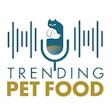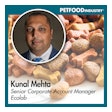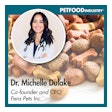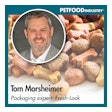
Cofounder and CEO of Bond Pet Foods Rich Kelleman answers the question, “What is this fermentation technology all about, and how can it apply to pet food?”
The below transcript is from Episode 44 of the Trending: Pet Food podcast, where host Lindsay Beaton spoke with Rich Kelleman, cofounder and CEO of Bond Pet Foods, about the fermentation process and how it could impact pet food manufacturing. You can find the episode at Trending: Pet Food Podcast, on SoundCloud or on your favorite podcast platform. This episode originally aired in October 2023.
We want to thank AFB International for sponsoring this podcast. AFB is the premier supplier of palatants to pet food companies worldwide, offering off-the-shelf and custom solutions and services that make pet food, treats and supplements taste great.
Lindsay Beaton – Editor, Petfood Industry magazine and Host, Trending: Pet Food podcast: Hello, and welcome to Trending: Pet Food, the industry podcast where we cover all the latest hot topics and trends in pet food. I’m your host and editor of Petfood Industry magazine, Lindsay Beaton, and I’m here today with Rich Kelleman, cofounder and CEO of Bond Pet Foods. Hi, Rich, and welcome!
Rich Kelleman, cofounder and CEO of Bond Pet Foods: Hey, Lindsay, good to be here.
Beaton: Before diving into the world of pets and food tech, Rich was a vice president and director at some of the world’s most respected advertising agencies, including CP+B, FCB and Fallon, where he led brand strategy for Burger King, P&G, Kellogg’s and Coca-Cola, among others. Rich has a B.A. in marketing from Boston College, with additional study at Stanford University’s Center for Social Innovation.
Bond Pet Foods is a Boulder, Colorado, U.S.-based company using biotechnology to create meat proteins that are nutritionally comparable to their conventional counterparts but without all the bad stuff — so people, pets, farm animals and the planet all win. Using some of the same processes that are employed in craft brewing, Bond produces high-quality animal proteins through fermentation, harvests them to better meet the nutritional requirements of companion animals, and supplies the ingredients to manufacturers for pet food, treat and supplement applications. Rich’s unconventional entry into the pet food space, and especially Bond’s premise of fermentation-produced animal protein, is why I’ve brought him on today to answer this question: What is this fermentation technology all about, and how can it apply to pet food?
Rich, I want to talk about your origin story a little bit in the pet food space, because those are always interesting to me. Where did this idea come from for you? And how did you get involved?
Kelleman: It was the natural evolution of my career to start Bond, since the last 25 years have mainly been at ad agencies helping different companies really formulate and execute their own marketing strategies. Ironically, just talking about alternative protein 12-13 years ago, an account that brought me out to Boulder, Colorado, for an ad agency here was the Burger King account.
At that time, BK was trying to better understand how they can compete with the likes of Chipotle and Panera Bread, who are redefining what quality meant in fast food. That meant that I, as a brand strategist, and my team, we were working with a different set of stakeholders. It wasn't just the CMO and brand team, but it was ingredient procurement, product innovation, and the like.
Long story short, that whole discourse and dialogue opened my eyes to the challenges that are attached to conventional agriculture, especially the procurement of meat. In addition to working through that initiative with Burger King, I dangerously started to read on the side books, like eating animals and Omnivore's Dilemma, just out of personal curiosity about our food system. I became a vegan working on Burger King, which led to some interesting client conversations. That impetus, beyond that personal shift and food sensibility, was just a heightened awareness of topics around animal welfare, sustainability, safety of our food and the supply chain. That made me shift toward that kind of sensibility, toward my own personal convictions about food.
Flashforward, after that experience, a few years later, my wife and I got our first dog together, Rumples. And with Rumples I wrestled with that tension of having to feed her and our cats meat just because of this new way that I was wired toward food. We had no intention on making Rumples and our cats vegan because meat can be a beautiful thing for their nutrition and their health. I just started to ask the question at that time, could there be a better way to give them the nutrition they need?
Without all the farm animal welfare, environmental and safety downsides, it was just a personal curiosity of something I wanted to discover. As I was stewing on that thought, companies that you may or may not be aware of on the human food side, like Perfect Day Foods was working on a milk protein, Clara Foods, now The EVERY Company, was working on egg proteins. More ambitiously, Upside Foods was working on structured steak and chicken breast for human consumption. They were all starting to beat the drum about being able to reproduce all these foods that we know and love through food technology.
I was fascinated by it. To be honest with you, not initially because I was connecting the dots to what would become Bond and this personal attention that I mentioned, but as s a vegan, I missed cheese so much! I figured one day, somebody will crack the code on that, and then I'll die a happy man. The more that I realized and understood about the foundational platforms these new companies were employing to make their products, I quickly realized that if a company could solve a similar problem for pet food, the path to commercialization could be relatively easier.
What I mean by that is -- for dogs and cats, you don't have to fully recapitulate that meat-eating experience. It's not about the sizzle, the mouthfeel, the texture that must be so perfect for us to embrace it. For dogs and cats, it must taste good, because now it tastes like chicken. It's more about the nutritional equivalency and bioavailability more than it is about the experience of eating meat, per se.
I just felt like, even though this wasn't my trade, if I could assemble the right brain trust, we could do something special. It took me a bit of time to find my cofounder, who was seasoned, and a relevant form of technology, to bring in some board-certified veterinary nutritionist who could give us counsel on the meat protein specification that we're aiming for, to bring in seasoned veterans in the ingredient industry who had successfully scaled different enzymes, proteins, products, or people and pets over the course of their careers.
Once we had that nucleus put together, we assessed the different ways that we could approach meat production, landed on a process called precision fermentation as our chassis for making these high-value ingredients. Then we were off to the races. When I say off to the races, as any startup knows, like things go in fits and starts as you're trying to get something new and novel off the ground. In a long-winded way, that's our origin story and how we came to be.
Beaton: Did it take a lot of convincing as you were putting the team together? Or a lot of initial education about what your vision was? Or are there a lot of people out there in the pet space, especially veterinarians, who are ready for this kind of thing and jumped at the chance to be part of it?
Kelleman: Tremendous amount of education that we had to do just to give everyone a clear framing of, not only why we're doing this and why it is important to look at diversification of the protein supply chain in the pet food industry, but also the mechanics of how we go about our business to make this finished good, this ingredient.
There was a lot of that, and we still need to do a lot on that score with different stakeholders. Initially, when we were emerging, the industry was even more nascent than it is today. There was a lot of foundational conversations that we had just to get people excited and comfortable with this new way of thinking about foundational proteins for our pets.
Beaton: We are going to talk about education a little bit more later, because regular listeners of this podcast know that I love a good industry education conversation. For now, I want to dive into what the technology is and how it compares to the other types of alternative protein technologies going on out there right now. Because there's lab-grown meat, there are other fermentation processes. You mentioned a milk protein. There are proteins that will replace meat. Then there are other ways of creating meat that are happening right now. How did you settle on precision fermentation for the process that you were most interested in doing? And what does that technology look like compared to some of the other things going on right now?
Kelleman: Our process precision fermentation has been a technology that's been around for more than half a century, to make everything from enzymes for cheese manufacture to good bacteria for probiotic supplements to vitamin B12 to lactic acid -- a host of different ingredients that are used in our diet today. If you eaten cheese, which I'm sure you have … decades in the past, the way cheese was made was in part through an enzyme that helps separate the curds in the whey. That was harvested, by and large, from the fourth stomach of a baby calf. As the demand for cheese grew around the world, it became a process and protocol that became increasingly more expensive, less scalable.
Some smart scientists realized just borrowing from how fermentation was used in other industries -- for example in pharma and medical applications where they're using precision fermentation to make different vitamins and drugs and other things that we routinely consume -- that instead of harvesting it conventionally on farm and field, they could take a harmless biopsy from a baby calf, isolate within that sample DNA what would produce and express the enzyme that they were looking for, couple that with either food-grade strain of yeast or fungi, put that into a fermentation tank, and basically ferment it. Feed that yeast simple sugars, vitamin salts, minerals, and as the yeast grows -- the native yeast -- the functional protein, grows as well. In that case, that enzyme they're looking to get their mitts on, or in the cheese industry, cheese production.
What we're doing is reassembling the process to -- instead of making an enzyme for cheese manufacture, vitamin B12, lactic acid, etc. -- to harvest skeletal muscle protein -- meat protein -- that can be foundational for pet health.
Again, it’s a technology platform that's been around for quite some time. We're just being creative with how we're approaching that process, so that we can harvest these meat proteins that could be the primary input into any pet food recipe.
Beaton: Did you know it was going to work?
Kelleman: We had a high confidence. After we really looked at the literature of what yeast could support as a host microorganism, the kind of proteins that we're looking at, that it could work. But you never know until you get the team on it. It's science, right?
We were quickly able to demonstrate even at an early stage, that we could make chicken protein, turkey protein. Again, it's the protein, the essential amino acids, that we're looking for that are the engine for the pet food recipe. We expressed those -- turkey, beef, salmon, a host of others -- filed some foundational patents. Then from there, we were able to close an initial seed round -- this is a little over three years ago -- so that we could build out a proper small food lab to run faster with our work and bring in some additional senior scientists that could help with strain engineering and process development.
Then we were able to make bigger strides with our work to show not only that we could do it but have a look at its nutritionals to ensure that this is something that could be just as critical for any pet food recipe, a foundation for any pet food recipe. That showed the prospect of promise of being just as bioavailable as conventional meat proteins that are currently used in market.
Beaton: This might be getting into the weeds, but I'm interested, so I'm going to ask it anyway. Are certain proteins easier to work with on a molecular level? Like is salmon more difficult than beef more difficult than chicken? Or is it all the same from scientists’ perspective?
Kelleman: Depending on the species, it can be easier to work with a chicken protein since chicken has been mapped and studied for quite some time, so there's a lot of data there to draw from.
There could be more novel proteins out there, like buffalo or something like that, that doesn't have that kind of historical use and rigor for other kinds of applications. Then we would just need to do some more analytics and work to make sure that we have all the data we need before we start experimenting with the proteins within the species.
That's something else that's worth mentioning -- a sample of chicken meat could have hundreds of different kinds of proteins within that sample. What we're doing is mining the kinds of meat proteins that can have the greatest value for pet health to support their diet. There's some that could be just supporting cast proteins that are part of its proximate analysis. Then there could be others that could make a greater contribution to the kinds of things that pets need to be healthy and thrive.
Basically, we assess the proteins that will give a dog or cat the greater level of essential amino acids that they need as part of a finished product, a diet. Then we use precision fermentation as a method to express and produce those proteins through the manufacturing process. It's not like we're reducing all the chicken meat proteins that you get on farm and field. We're producing the ones that have the most beneficial value for dog and cat health.
Beaton: We've been touching on this question a little bit in terms of technological challenges and education challenges, which now's the time to get into that. What have been some of the biggest challenges in getting Bond Pet Foods off the ground and in getting support for what's essentially a new way of using a technology in the pet food industry?
Kelleman: I think we've been pleasantly surprised, thankfully, for the interest and curiosity from industry, investors and even pet parents who have stumbled on us and discovered us. Part of that is, even though all these different stakeholders at first blush don't understand the full nuance of what we're doing, there is a drive by all these individuals and groups to look for more sustainable options for what they're bringing home and into their cupboards or what they're using and their formulary work for product development.
From an investor's standpoint, more and more venture capitalists, family funds, and strategic funds are also looking at sustainability as one of their top criteria for companies that they want to invest in. Through all those different lenses, we have something that, at least on the surface, many of these different groups and individuals are very interested in.
Now, when it comes to showing what this is and why it could be an exciting way to think about meat for the pet food industry, there are a couple of things to point out. First, there was a study that was done about five years ago by some researchers at UCLA that attempted to examine the environmental impact of America's dogs and cats and their dietary consumption of meat.
There are a couple of interesting findings at a high level from that study. The first is that if America's dogs and cats were their own country, their consumption of meat products alone would rank fifth in the world. They're voracious consumers of meat.
The second piece of data from that suggested that up to 30% of all the negative environmental impacts -- from this consumption from our dogs and cats -- can be attributed to them. When you think of GHG, emissions, land, water energy used, even accounting for byproducts that are routinely used in the pet food industry, almost a third of all the things that we’re challenged to try to solve from a sustainability standpoint, come from this industry. There is a real problem to be solved here.
If we can harvest meat protein more efficiently and responsibly, exploring different methods, then there is great merit in that. Sharing some of that with all these different groups also open their eyes to be receptive to hearing about our solution.
That's the first thing -- the why. Why do you think that this is something when it comes to reimagining meat that needs to be addressed for the pet food industry in this business vertical? Once we share some of that insight from the impact that we could have -- if we took a different way of producing and making meat -- then it's about talking at a more granular level of how this process works.
I think the one beautiful thing about fermentation is that it’s been around for generations to make, even in a traditional sense, a multitude of different kinds of foods that we know and love. Precision fermentation is an evolution of that technology, but you're still using some of the same kinds of vessels and equipment. If you walked into Bonds’ food lab, in addition to smelling that delicious yeast brewing, in some ways it looks like your craft brewery around the corner or if you walked into Coors Brewing or another brand manufacturer. what you would see is very similar to those kinds of manufacturing plants that have existed for quite some time.
It's not a scary process, right? It's us basically being creative with how we're teaching that yeast to produce these high-value ingredients that could really play a role in pet food space.
Beaton: Where are you at right now with Bond Pet Foods and with this technology? And where do you want to take it in the next several years? Where do you think it's place will eventually settle in the pet food industry?
Kelleman: Right now, we've gone well beyond foundational R&D to getting two meat proteins ready for commercialization. Meaning, we've been able to get two meat proteins to a place where they're demonstrating they can scale at the right capacity, and they are behaving as we intend them to within the fermentation tanks to give us the kind of volume and harvest that we're looking for.
The nutritional specifications look wonderful as that foundational protein for a potential partner. We've gotten these two products ready to go. With that, we're now starting that process of going from benchtop, small-scale to producing the amount of kilograms that are required to introduce these proteins in a finished product for the FDA’s Center for Veterinary Medicine (CVM) regulatory process. We’ll be fully evaluating their performance and efficacy over the course of the next six to 12 months, collaborating with the FDA’s CVM to ensure this is something that is safe, nutritious and effective when used at a high inclusion in a pet food formulation.
Beaton: Was scalability a little bit of a fingers-crossed, hold-your-breath moment, because there's a big difference between being able to come up with something in a lab and saying, “Yay, we did a thing!” And then being able to mass produce that thing. I know the ability to scale up is the bane of a lot of small pet companies’ existences. Was that a big success -- once you realized it was going to scale up enough that you could take the next step?
Kelleman: Yeah, that is something else -- like on the research side -- that goes in fits and starts. We were learning for the first time through those initial rungs. How, for example, can we control the different levers of a fermentation with his pH and pressure? And how do you feed the yeast and at what frequency so that we can get that higher yield that we were looking for?
There is a process of discovery there, but we've got that down now. We have a line of sight. We're at full scale and process optimization where we can be price competitive with conventional proteins that are currently in the market. For example, with our chicken meat protein products side by side with high-quality chicken meal, dried bone broth, chicken breast trim, we can compete at a price per kilogram and it’s attractive for industry.
I think that’s something that is exciting about this approach with employing precision fermentation to make these meat protein ingredients -- we aren't inventing a wholly new process of ingredient production. We're being creative with it and how we're assembling it to produce something that could have value for this industry and for this consumer. It's not like we're starting with a moonshot assignment of being able to produce this in a wholly different way.
We know how we can step ahead with what's come before us to create something that ultimately will be usable and valuable with that cost structure that will be required for this specific application.
Beaton: I want to wrap up our conversation by stepping back and looking at the larger picture. Because right now, alternative proteins in the pet space are a significant cost investment. Depends on the protein, but it's outside the norm or the tradition of what pet food has been in the past. And a lot of times, you're also looking at the human food industry, which is researching all this same stuff that the pet food industry is researching. A lot of companies are in both spaces right now when it comes to alternative proteins. Where do you believe alternative proteins will settle in the pet food space and how do you think they are going to grow and evolve pet food?
Kelleman: That's a great question. There's a need for all these different kinds of solutions in the pet food space. When it comes to protein, whether it's plant-based ingredients and proteins, insect protein, cell-cultured meat products, there are some great companies that are working on that. In addition to microbial proteins and novel proteins that are made through precision fermentation, so everything from pure yeast to something like ours, that is employing yeast to make something that has a different kind of nutritional quality and specification.
I think all of these will be important to give manufacturers a suite of options at their disposal where they can, as they evolve their product and proposition, create products that have a lower carbon footprint. Products that, perhaps through the combination of these ingredients have improved nutritional credentials and perform in making the kind of impact in the industry that everybody is attempting to have, and consumers are starting to demand. In terms of finished products that have a greater level of responsibility baked in.
The way I look at the future of pet food, with all these different companies and these technologies emerging, as a great Renaissance. There’s this transformation that's happening, where in 10 years’ time, food could look quite different and perhaps for the better, just by how these different companies and manufacturers that are leading the way have been able to utilize the suite of options that are in front of them.
I do think that at Bond, we have a solution that is unique amongst this set. As I mentioned earlier, it's wholly scalable. We're not creating this new kind of process of ingredient production. We're using a system that's been around for quite some time, so that we can create something with the cost structure that makes sense for industry.
Also, we're employing this process to produce something we believe will be culturally satisfying. We aren't creating a meat analogue or trying to replicate the nutritional credentials of meat through plant-based sources or create something that is comparable through another kind of harvest, like insect production, insect meal or protein production.
We're making meat protein. Chicken, turkey, fish and other kinds of meat proteins that people are used to buying will still be part of its finished specification as part of that product and recipe. Because of that, we think there is an opportunity to move people more broadly to give this product a try and embrace it and have it become part of their and their dogs’ and cats’ feeding routines.
Beaton: Rich, thanks so much for sitting down with me today. Being able to expose my audience to new technologies that can be used in the pet food space is one of the reasons I wanted to start this podcast. It was great to talk to you about something so innovative and with a lot of potential for the industry. Before we go, let’s do a little plug: where can people find more information about you and Bond Pet Foods?
Kelleman: We have a website, bondpets.com, where anyone can learn more about our technology, the team that's behind it and the momentum that we have. We're active on LinkedIn and Instagram, if anybody wanted to get more of our play-by-play of how it's pacing with our technology, our partnerships and our business as a whole.
Beaton: Excellent. That’s it for this episode of Trending: Pet Food. You can find us on petfoodindustry.com, SoundCloud or your favorite podcast platform. You can also follow us on Instagram at @trendingpetfoodpodcast. And, if you want to chat or have any feedback, I’d love to hear from you! Feel free to drop me an email: [email protected]. And of course, thanks again to our sponsor, AFB International, the premier supplier of palatants to pet food companies worldwide offering off-the-shelf and custom solutions that make pet food, treats and supplements taste great.
Once again, I’m Lindsay Beaton, your host and editor of Petfood Industry magazine, and we’ll talk to you next time. Thanks for tuning in!

















